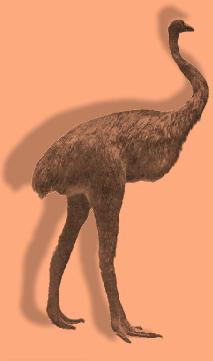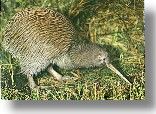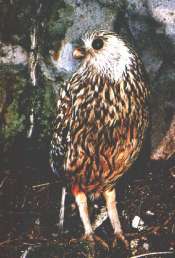BIRDS
The birds of New Zealand are one of it's most distinguishing features. It has
over 70 species of birds found nowhere else. Over 1/3 of it's birds are flightless,
and almost 1/4 are nocturnal.
Because New Zealand is devoid of any native land mammals (except for the bat), the
bird population has taken over many ecological niches that we are used to seeing filled
by mammals. To fill these niches, many birds had to adapt by developing unusual
characteristics such as "flightlessness, gigantism, low clutch sizes, criptique plumage
patterns, and nocturnal behavior."

 Most birds that show gigantism are herbivors. This is thought to be attributed to the
low food value of plants. It is an advantage to be able to intake and
process large amounts of food at once. A bigger size, therefore, means greater
efficiency. Another advantage of being large is that "large animals use less energy
per unit weight than small animals". Many large birds, such as the now extinct moa,
the goose, the takahe, and the kakapo became flightless due to their increased size.
This was only possible because New Zealand did not have any ground predators.
Most birds that show gigantism are herbivors. This is thought to be attributed to the
low food value of plants. It is an advantage to be able to intake and
process large amounts of food at once. A bigger size, therefore, means greater
efficiency. Another advantage of being large is that "large animals use less energy
per unit weight than small animals". Many large birds, such as the now extinct moa,
the goose, the takahe, and the kakapo became flightless due to their increased size.
This was only possible because New Zealand did not have any ground predators.
 The moa was a giant bird (up to 3m in height). It was part of the ratite family which
also includes the kiwi, the ostrich, and the emu. This large bird resembled an ostrich,
but had no wings. It was a herbivor and ate woody twigs, leaves, seeds of forest trees,
and vines. It is thought to have become extinct about 400-500 years ago due to hunting (mostly by man) and destruction
of their natural habitat.
The moa was a giant bird (up to 3m in height). It was part of the ratite family which
also includes the kiwi, the ostrich, and the emu. This large bird resembled an ostrich,
but had no wings. It was a herbivor and ate woody twigs, leaves, seeds of forest trees,
and vines. It is thought to have become extinct about 400-500 years ago due to hunting (mostly by man) and destruction
of their natural habitat.
There are also a number of smaller sized flightless birds such as the snipe rail,
Finsch's duck. These birds were tempted into becoming flightless by the lack of
ground predators.
 Although native ground predators are lacking, many proficient avian predators can
be found. These birds feasted on other birds, as well as insects, bats, amphibians,
and reptiles. The presence of these avain predators caused the birds of prey to
develope intricate camouflage patterns as well as to become nocturnal. Almost all
of these predatory birds hunt during the day. The only exeption are the now extinct
laughing owl and the owlet-nightjar.
Although native ground predators are lacking, many proficient avian predators can
be found. These birds feasted on other birds, as well as insects, bats, amphibians,
and reptiles. The presence of these avain predators caused the birds of prey to
develope intricate camouflage patterns as well as to become nocturnal. Almost all
of these predatory birds hunt during the day. The only exeption are the now extinct
laughing owl and the owlet-nightjar.
 One of the most impressive of the predatory birds was Haast's Eagle. This eagle,
a forest dweller, was the largest and most powerful eagle in the
world. The typical weight for a male eagle would have been 9-10 kilograms and 10-12
kilograms for females. The largest female weighed 9-10 kilograms and had a wing span
of 2.8 meters. These eagles ate large birds, such as pigeons, geese, and even adult
moas. In order to compture a moa, the eagle would perch itseld high on a branch and
wait for it's prey to come within range. When this happened, it would dive at high
speed and ram into the moa. The impact would knock the moa to the ground. The eagle
would then use its 75mm talons to "crush and pierce the neck and skull of the
immobilised prey". Because the eagle was the largest predator around, it could stay
near it's catch for several days. Haast's Eagle became extinct several hundred years
ago, probably due to the many enviromental changes due to man's presence.
One of the most impressive of the predatory birds was Haast's Eagle. This eagle,
a forest dweller, was the largest and most powerful eagle in the
world. The typical weight for a male eagle would have been 9-10 kilograms and 10-12
kilograms for females. The largest female weighed 9-10 kilograms and had a wing span
of 2.8 meters. These eagles ate large birds, such as pigeons, geese, and even adult
moas. In order to compture a moa, the eagle would perch itseld high on a branch and
wait for it's prey to come within range. When this happened, it would dive at high
speed and ram into the moa. The impact would knock the moa to the ground. The eagle
would then use its 75mm talons to "crush and pierce the neck and skull of the
immobilised prey". Because the eagle was the largest predator around, it could stay
near it's catch for several days. Haast's Eagle became extinct several hundred years
ago, probably due to the many enviromental changes due to man's presence.
The forest's of today are "quite, eerily so, and empty of animals compared to
pre-human times". Many of the unique specialized specied were extremely vulnerable
to the changes in it's ecology, and were all too easy prey to man, dogs, and rats.
back to "FLORA and FAUNA"

 Most birds that show gigantism are herbivors. This is thought to be attributed to the
low food value of plants. It is an advantage to be able to intake and
process large amounts of food at once. A bigger size, therefore, means greater
efficiency. Another advantage of being large is that "large animals use less energy
per unit weight than small animals". Many large birds, such as the now extinct moa,
the goose, the takahe, and the kakapo became flightless due to their increased size.
This was only possible because New Zealand did not have any ground predators.
Most birds that show gigantism are herbivors. This is thought to be attributed to the
low food value of plants. It is an advantage to be able to intake and
process large amounts of food at once. A bigger size, therefore, means greater
efficiency. Another advantage of being large is that "large animals use less energy
per unit weight than small animals". Many large birds, such as the now extinct moa,
the goose, the takahe, and the kakapo became flightless due to their increased size.
This was only possible because New Zealand did not have any ground predators.
 The moa was a giant bird (up to 3m in height). It was part of the ratite family which
also includes the kiwi, the ostrich, and the emu. This large bird resembled an ostrich,
but had no wings. It was a herbivor and ate woody twigs, leaves, seeds of forest trees,
and vines. It is thought to have become extinct about 400-500 years ago due to hunting (mostly by man) and destruction
of their natural habitat.
The moa was a giant bird (up to 3m in height). It was part of the ratite family which
also includes the kiwi, the ostrich, and the emu. This large bird resembled an ostrich,
but had no wings. It was a herbivor and ate woody twigs, leaves, seeds of forest trees,
and vines. It is thought to have become extinct about 400-500 years ago due to hunting (mostly by man) and destruction
of their natural habitat.
 Although native ground predators are lacking, many proficient avian predators can
be found. These birds feasted on other birds, as well as insects, bats, amphibians,
and reptiles. The presence of these avain predators caused the birds of prey to
develope intricate camouflage patterns as well as to become nocturnal. Almost all
of these predatory birds hunt during the day. The only exeption are the now extinct
laughing owl and the owlet-nightjar.
Although native ground predators are lacking, many proficient avian predators can
be found. These birds feasted on other birds, as well as insects, bats, amphibians,
and reptiles. The presence of these avain predators caused the birds of prey to
develope intricate camouflage patterns as well as to become nocturnal. Almost all
of these predatory birds hunt during the day. The only exeption are the now extinct
laughing owl and the owlet-nightjar.
 One of the most impressive of the predatory birds was Haast's Eagle. This eagle,
a forest dweller, was the largest and most powerful eagle in the
world. The typical weight for a male eagle would have been 9-10 kilograms and 10-12
kilograms for females. The largest female weighed 9-10 kilograms and had a wing span
of 2.8 meters. These eagles ate large birds, such as pigeons, geese, and even adult
moas. In order to compture a moa, the eagle would perch itseld high on a branch and
wait for it's prey to come within range. When this happened, it would dive at high
speed and ram into the moa. The impact would knock the moa to the ground. The eagle
would then use its 75mm talons to "crush and pierce the neck and skull of the
immobilised prey". Because the eagle was the largest predator around, it could stay
near it's catch for several days. Haast's Eagle became extinct several hundred years
ago, probably due to the many enviromental changes due to man's presence.
One of the most impressive of the predatory birds was Haast's Eagle. This eagle,
a forest dweller, was the largest and most powerful eagle in the
world. The typical weight for a male eagle would have been 9-10 kilograms and 10-12
kilograms for females. The largest female weighed 9-10 kilograms and had a wing span
of 2.8 meters. These eagles ate large birds, such as pigeons, geese, and even adult
moas. In order to compture a moa, the eagle would perch itseld high on a branch and
wait for it's prey to come within range. When this happened, it would dive at high
speed and ram into the moa. The impact would knock the moa to the ground. The eagle
would then use its 75mm talons to "crush and pierce the neck and skull of the
immobilised prey". Because the eagle was the largest predator around, it could stay
near it's catch for several days. Haast's Eagle became extinct several hundred years
ago, probably due to the many enviromental changes due to man's presence.